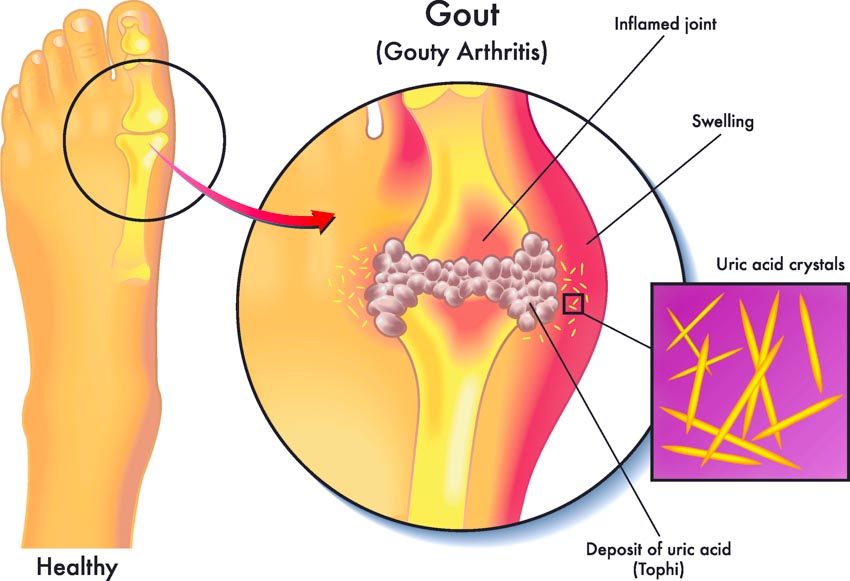Acupuncture is an effective treatment modality for the alleviation of gout. Foshan Hospital of Traditional Chinese Medicine researchers combined auricular acupuncture with warm needle acupuncture and determined that the combined approach significantly enhances the efficacy of drug therapy. Drug monotherapy produced an 81.67% total effictive rate. Adding acupuncture into the therapeutic regimen of care increased the total effective to 95%. Equally as important, the fully recovered rate was significantly higher in patients that received acupuncture.
A 10-point visual analogue scale (VAS) for joint pain was used to assess pain levels. Blood tests were conducted before and after treatment to determine blood uric acid levels. The efficacy rates were classified into the following 4 levels:
- Fully recovered: Symptoms disappeared, mobility restored, blood uric acid dropped by over 80%
- Significantly effective: Symptoms markedly relieved, mobility markedly improved, blood uric acid dropped by 60% to 80%
- Effective: Symptoms relieved, mobility improved, blood uric acid dropped by 40% to 60%
- Ineffective: Symptoms persisted, mobility impaired, blood uric acid remained the same
In the acupuncture group, 28 cases fully recovered, 24 were significantly effective, 5 were effective, and 3 were ineffective. In the control group, 20 fully recovered, 23 were significantly effective, 6 were effective, and 11 were ineffective. The total efficactive rate was 95% in the acupuncture group, higher than that of the drug monotherapy group at 81.67%. [1]
VAS scores changed more significantly in the acupuncture group from 7.13 ±0.56 to 2.10 ±0.14, while the change in the drug monotheray group was smaller, from 7.09 ±0.58 to 3.37 ±0.26. Blood uric acid also had a bigger reductions in the acupuncture group, falling from 540.83 ±60.68 to 326.85±45.63. The figure for blood uric acid before and after treatment in the drug monotherapy group was 541.07 ±60.14 and 380.99 ±46.15 respectively. Based on the data, the researchers confirm that acupuncture helps to relieve pain in the joints, improve joint flexibility, and reduces blood uric acid levels.
For all patients in the study, alcohol and food high in purine was strictly forbidden for both groups. Gout (hyperuricemia) is a type of inflammatory arthritis wherein there is excess uric acid in the body. Uric acid is produced when purines are processed in the body. Uric acid crystals accumulate in the joints, bodily fluids, and tissues and may lead to inflammation and pain. Examples of foods high in purine are anchovies, grains, herring, liver, mackerel, mussels, sardines, and yeast. Learn more in the acupuncture CEU course Gout Treatments at HealthCMi.
In addition to dietary therapy, both groups were prescribed celecoxib (0.2 g per day, taken daily) for ten consecutive days. Known by its brand name CeleBREX, this is a Cox-2 inhibitor that is a non-steroidal anti-inflammatory (NSAID) medication. Celecoxib achieves its effective action by reducing hormones in the body that are responsible for pain and inflammation. Patients in the acupuncture group received identical dietary and drug therapy plus the addition of the following acupoints:
- Sympathetic (AH6a, Jiaogan: auricular)
- Endocrine (CO18, Neifenmi: auricular)
- HT7 (Shenmen)
- BL23 (Shenshu)
Acupuncture needles (0.30 ×25 mm) were inserted and slightly twisted to achieve a numbing or swelling sensation. After obtaining deqi, needles were retained for 20 minutes. This procedure was conducted on alternate days for 10 days.
As for the warm needle acupuncture treatment, it was administered daily. Filliform needles (0.30 mm × 50 mm) were used. After arrival of deqi, needles were connected with 2 cm of moxa at the ends. Two moxa pieces were used for each point. The following points were used:
- BL23 (Shenshu)
- BL20 (Pishu)
- BL17 (Geshu)
- GB34 (Yanglingquan)
- SP3 (Taibai)
This 10-day course of intensive care produced signfiicant relief from pain and improvements in blood uric acid levels. The addition of acupuncture to the regimen of care produced greater patient outcomes over drug monotherapy.
The study employed a sample size of 120 patients from May 2019 to May 2020. For all paitents, gout was diagnosed by a physician and uric acid crystals were identified in the synovial fluid and tophi were documented. A tophus is an indication of gout. Under a microscope, tophi are structures consisting of monosodium urate (MSU) crystals, inflammatory cells, and connective tissues.
All patients were randomly divided into a drug control group and an acupuncture group, with 60 patients in each group. The drug control group consisted of 28 females and 32 males. Age range was 41 to 68 years. Mean age was 54.61 ±3.80 years. The course of disease ranged from 3 months to 4 years. Mean course of disease was 1.53 ±0.71 years. The acupuncture group consisted of 27 females and 33 males. Age range was 40 to 68 years. Mean age was 54.58 ±3.79 years. Course of disease ranged from 2 months to 3 years. Mean course of disease was 1.49 ±0.72 years.
The data confirms that acupuncture produces important clinical improvements. Given the level of structural damage, pain, inflammation, disability, and increased mortality risks associated with gout, the addition of acupuncture to a regimen of care is appropriate.
Reference:
1. Clinical Effects of Treating gout in Patients with Ear Acupuncture And Warm Acupuncture, Lu Junguang, Liting, Liang Jianliang, Inner Mongolia Journal of Traditional Chinese Medicine Vol.40, No.7, 2021.



